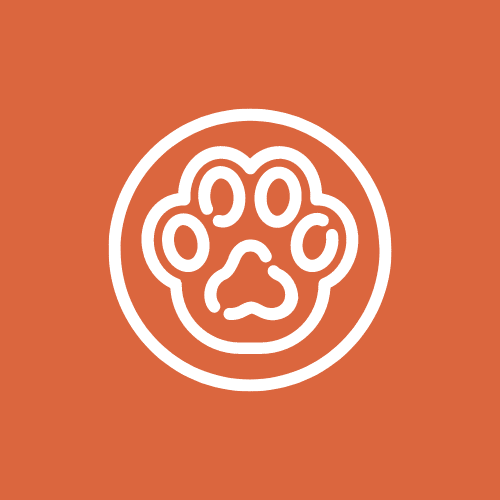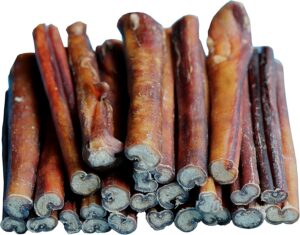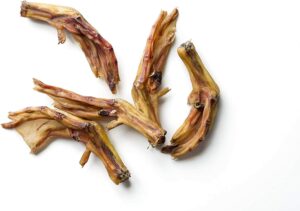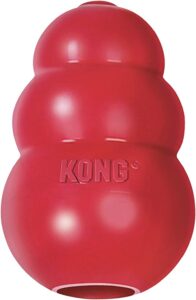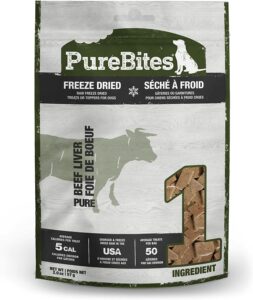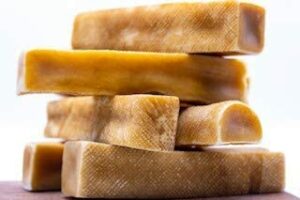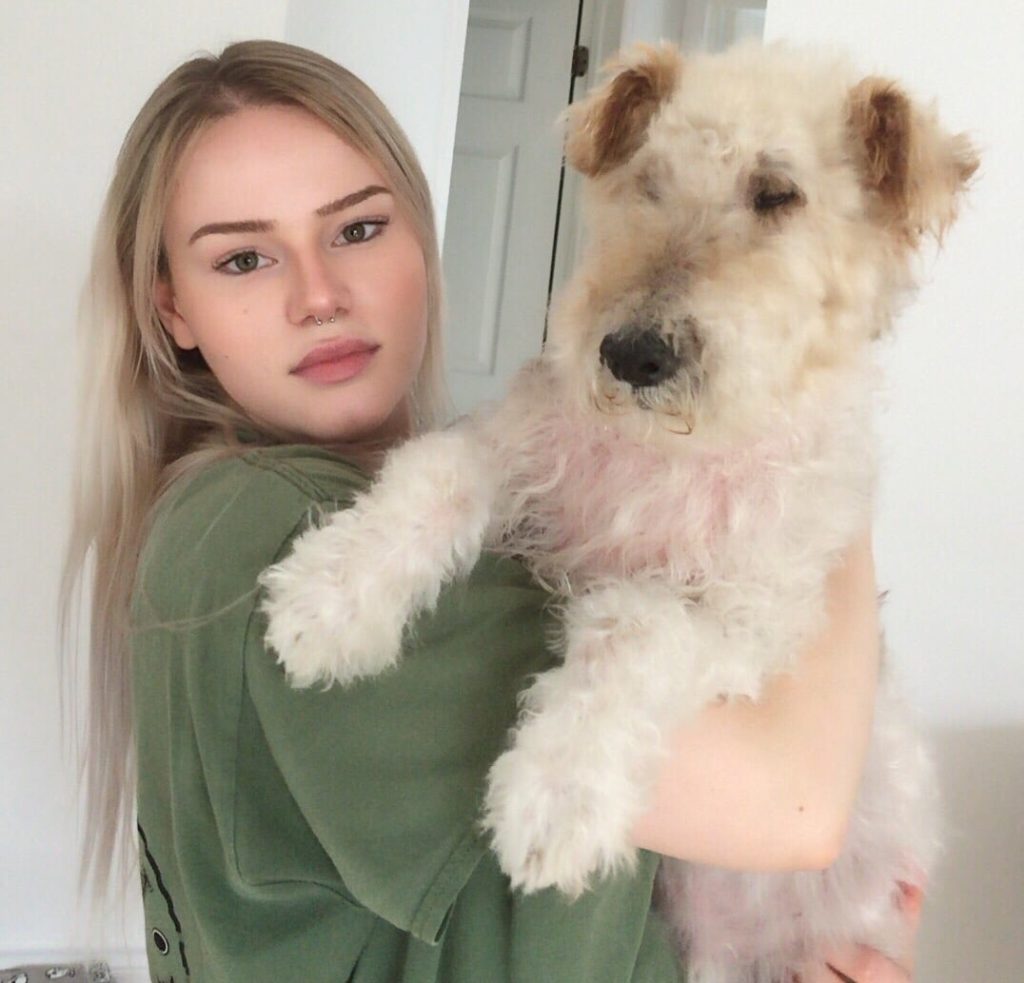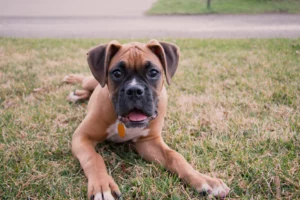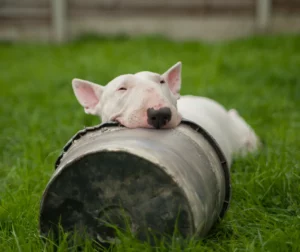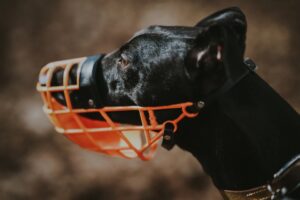It is difficult to know which dog bone to choose since there are so many different options as well as misinterpretations regarding which bones are safe and which to avoid.
To choose a good bone or chew toy for your dog, you must take into consideration several elements. That is, the way he chews, the strength of his jaw, his size, as well as his general health. Also, bones to avoid are mainly bones whose composition, country, or source of origin, and how they were processed are unknown.
The good news is that most bones and chew toys can be good. However, they must be chosen and used appropriately. In any case, your dog should always be supervised when you give him a chewing bone or toy.
In this article, we highlight how to safely use the most popular chewing bones and toys. As well as what one should avoid with each of them.
Bully Sticks and Jerky Treats
Bully sticks are beef jerky tendons and they are one of the best dog chews you can get for your dog. First, they are the perfect rawhide alternative. Then, they are easily digestible, natural, nutritious, made without chemicals, and can be found in different sizes.
Some brands might have a slightly stronger smell than other treats, but it varies from brand to brand.
Finally, bully sticks last a relatively long time. In addition, it cleans the teeth, which is very important when choosing a chewing bone for your dog. Moreover, high-quality bully sticks will last longer, have a less strong smell and they are often dogs’ favorite.
What to Avoid
If you buy the Jerky-type sticks, make sure it is the right size for your dog to avoid choking or obstructing his gastric system.
Just like every chew, never give your dog a chewing treat that’s too small for him. Chewing bones should always be proportional to the size of your dog.
Duck Feet
They are one the best dog chews for cleaning your dog’s teeth. On the one hand, fuck feet are loaded with vitamins like calcium, magnesium, glucosamine, and chondroitin. On the other hand, they are easy to digest, natural, and delicious for your dog.
What to Avoid
The only danger is that your dog might swallow it whole. So, if you know that your dog tends to ingest his treats too quickly, choosing another chew would be better. This is why it is important to supervise your dog when giving him a chewing treat. This way, you will avoid veterinary costs.
Kong and Treat-dispensing Toys
Interactive toys, such as Kong and West Paw Toppl, are becoming increasingly popular with many pet owners. Moreover, they are very good tools to occupy your dog by stimulating him mentally and physically.
You can garnish interactive toys with several ingredients. Use your creativity and create vitamin-packed and scrumptious recipes for your pet.
See our article on Kong to learn more about it. You will find a list of ingredients, as well as recipes to fill a Kong and how to choose it.
You can also use wet kibbles to fill a Kong. By using an interactive toy instead of a regular bowl, you will be able to help control your dog’s weight and prevent him from eating too quickly at mealtimes.
In addition, the best way to occupy your dog for as long as possible is to put a filled Kong in the freezer. Wait about 4 hours and take it out a few minutes before giving it to him. It is also a good technique to cool your dog on hot days or to help with puppy teething.
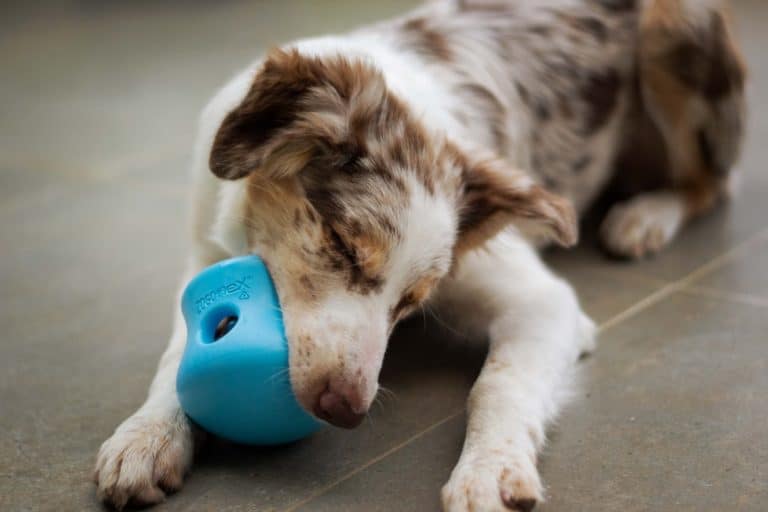
What to Avoid
When filling the interactive toy, be careful with fatty ingredients, especially if you have a dog that is prone to pancreatitis. Thus, you will avoid excess weight.
When choosing your Kong, make sure it is proportional to your dog and tough enough for hardened jaws. Visit their website to find out what size would be appropriate for your dog.
As you may know, the Kong is made of rubber, so if it’s too small or not sturdy enough, it could be ingested and cause gastrointestinal obstruction.
Also, interactive toys won’t clean your pet’s teeth, so don’t forget to give him a dog chew that promotes healthy teeth and gums. You can also brush his teeth which is the best option.
Finally, choose an interactive toy that isn’t too complicated to start with, so your dog doesn’t get discouraged too quickly. For example, if it’s the first time your dog is using a Kong, try putting soft foods easy to reach and avoid putting the Kong in the freezer.
Deer Antlers and Java Wood
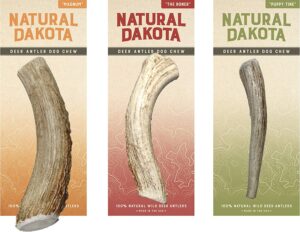
They are extremely tough, so it’s perfect for dogs with very strong jaws who tend to destroy their toy or devour their bone too quickly. They are wonderful for dogs that like to chew on wood, they are natural, they come in different sizes and they help to clean teeth.
No deer were harmed for their antlers! Deer antlers fall each year and are collected from the wild. Not to be confused with buffalo horns that crumble and are cut from the animal when dead.
What to Avoid
Since they are so dense, dogs can fracture their teeth while chewing on them, so if you know your dog has weaker teeth, this type of bone is not recommended. Dogs with weaker teeth are senior dogs, puppies, and dogs with dental diseases.
It’s a rare occurrence, but dogs that have frequent fractures sometimes have to undergo tooth extraction, which is expensive as well as painful.
On the other hand, those that are cut in half are much less resistant and easier to chew on. Finally, pay particular attention so that the antlers do not have any cracks that could injure your pet.
Raw Bones

Raw bones are a very good option, provided they are used properly. They are natural, are a source of minerals, calcium, and phosphorus, and are very tasty, especially those that still have meat around them. You can easily find them in pet stores.
According to veterinarian Gary Richter, raw bones are wonderful for cleaning your dog’s teeth, they can be easily digested, and they are very nutritious.
The supporting bones, such as the femurs and kneecaps, are the largest and they are strong, so they are ideal for large breeds with very strong jaws who tend to devour their bone too quickly.
Next, the safest bones for smaller dogs are poultry bones such as chicken wings and chicken or turkey necks. They are smaller and softer and, therefore easier to chew.
What to Avoid
Again, your pet can fracture their teeth, so if you’re worried about your pet’s teeth, give them a smaller bone, but big enough for their jaw.
In addition, bones with marrow are very fatty, so it is not recommended to give them too often to avoid pancreatitis.
Avoid giving a bone that is too small as he could ingest a large piece, which can cause gastrointestinal obstruction. Furthermore, it is not recommended to give weight-bearing bones to a puppy since their teeth are not hard enough.
As a general rule, bones that have a large hole in the center should be avoided, as it often happens that the dog’s lower jaw gets stuck in the center.
Like any raw meat, watch out for bacteria that could spread and cause illness. Most owners will give their dog a raw bone outside the house to prevent this from happening.
Dehydrated Treats
Dehydrated treats are great for small dogs because they are not very resistant. You can easily find dehydrated treats produced in Canada, such as the Quebec company PureBites, which offers a variety of high-quality meats.
Plus, their freeze-dried treats are a great way to reward your dog during training because they’re so tasty, light, and nutritious. They also have jerky-type treats similar to the bully stick mentioned above.
What to Avoid
However, it is important to know that pieces of dried meat or jerky will not clean your pet’s teeth. Also, take a good look at the ingredients, since you should only find meat that has been processed naturally. In other words, there should be no additives, preservatives, or salt in the ingredient list.
Either way, steer clear of low-quality treats, as several animals have been found dead after ingesting dried treats from China.
Yak Milk Chews
Also, called Yak cheese or Chhurpi, chewing Yak milk is an artisanal product from Nepal that is known to be an excellent source of protein and vitamins.
We can come across the same product but composed of cow’s milk which is made with the same health standards, as well as the same composition. It is a natural, practically lactose-free product that is very resistant and has a long shelf life.
In addition, it works effectively against tartar, it can be found in different sizes and when your dog has eaten almost all of it, you can put the leftover piece in the microwave, which will make a puffed treat for your canine friend.
What to Avoid
Dogs can break their teeth chewing on it since Yak cheese is very hard and made for strong jaws.
Finally, if it is not a cheese made with the traditional Nepalese recipe, your cheese could contain lactose and can cause digestive problems for your dog.
Rawhides
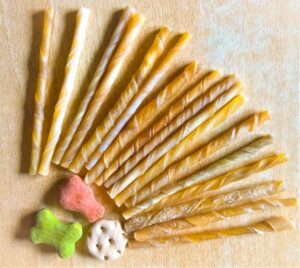
Rawhides are probably the most popular bones, as they are very affordable. They are made for dogs that chew slowly and they promote healthy gums and teeth.
What to Avoid
Rawhides are not recommended for many reasons.
First of all, they are not part of the food industry, but the leather industry. This means they don’t have to follow food production rules. It is also for this reason that they are often found in bulk and without packaging or that the package does not contain the chemical ingredients used during production.
Indeed, rawhide bones have been treated in chemical solutions, artificially colored, chemically glued, and contain traces of toxic products such as arsenic and mercury.
An investigation carried out by The Humane Society of United States and Humane Society International discovered rawhide treats made from the skins of dogs from Thailand. The manufacturers have confirmed that they regularly export them to North America and that they are sold in pet stores.
Finally rawhide bone can contain bacteria if not made responsibly, creating a digestive upset in your dog. If you want to know more, check out our article which explains in detail the dangers of rawhide.
Nylon Bones
Also called Nylabone, they are plastic bones designed to be chewed on, they can help clean teeth, and come in many flavors, but are inedible.
What to Avoid
Since plastic crumbles, your dog will likely ingest it over time. This is why it is important to keep an eye on this product and follow the safety advice on the packaging.
Again, the size should be appropriate for your dog’s size. In addition, you will avoid the risk of choking or gastrointestinal obstruction.
Also, it is not recommended to offer a nylon bone to a puppy. This is due to his still fragile teeth, but some are designed specifically for puppies.
The dangers of Cooked Bones
Cooked bones are extremely dangerous and provide no nutrients for your canine companion. Since they break too easily, they can, unfortunately, puncture organs or clog the throat.
Thus, cooked bones can result in expensive emergency surgery or even the death of your pet. That being said, the same goes for cats.
The Benefits of Chewing
In conclusion, chewing is natural in dogs and it brings many benefits. It helps your pet relax and stimulates his brain while maximizing his well-being.
On the other hand, it is better to invest in natural and quality products, instead of buying low-quality chewing bones. However, your dog could be injured, intoxicated or he could unfortunately die.
By investing in a good bone, you avoid veterinary costs by considering your pet’s health instead of neglecting it. Remember that by choosing high quality for your pet, you are also choosing its longevity!
Bibliographic Sources:
RENARD, Charlotte. «Le danger des bois de cerf à mâcher pour chiens», Direct-Vet.
LETENDRE, Martin (2017). «Rawhide (“os” en cuir): la gâterie qui tue!», Au Nom du Chien.
